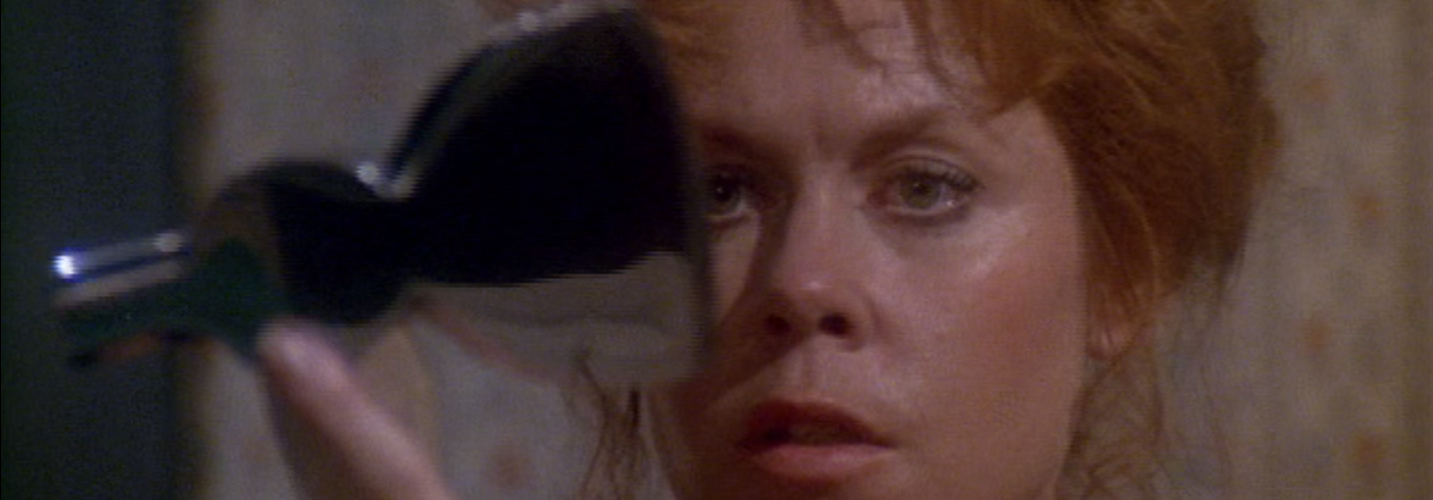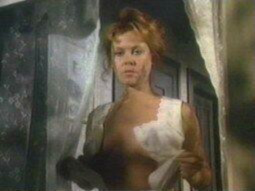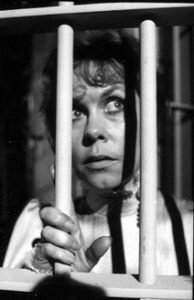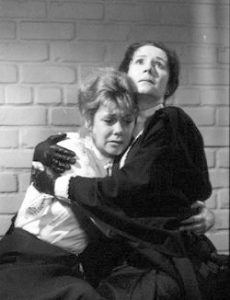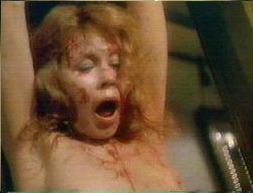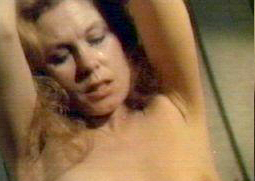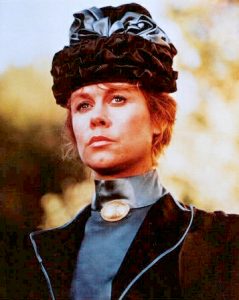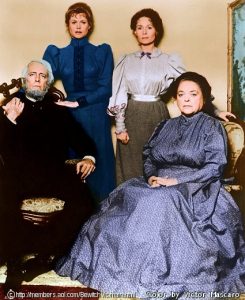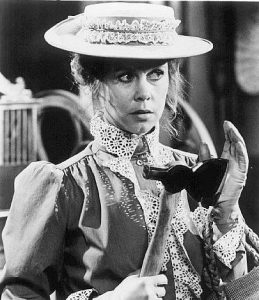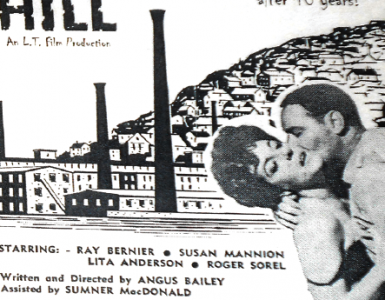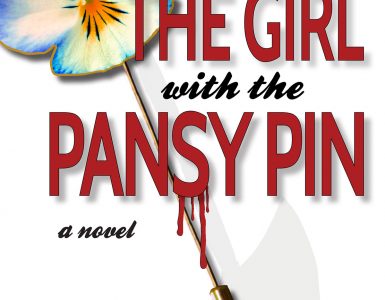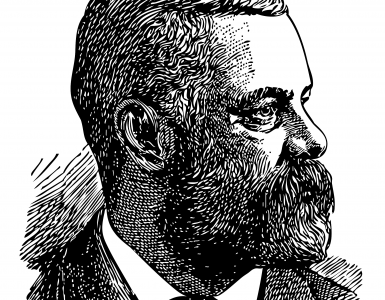by Eugene Hosey
An analysis of the 1975 television movie starring Elizabeth Montgomery
First published in April/May, 2005, Volume 2, Issue 2, The Hatchet: Journal of Lizzie Borden Studies.
Just forget the long list of tedious questions. She did it all by herself without an accomplice. Founded on the basis that the most sensational, and at the same time simple, theory makes for the most effective thriller, The Legend of Lizzie Borden explores the uncanny particulars of how she got away with it. The answer to the puzzlement was just too outrageous and obscene to be believed. Yet how cleverly practical was Lizzie’s idea to denude, kill, and then wash herself. Who could have imagined it without a cynical chuckle or a repulsed dismissal? In fact, Lizzie’s own Defense introduced the idea to show the absurdity of the Prosecution’s case [1]. But the magical medium of the motion picture makes the nude method of murder compelling enough to suspend disbelief for the duration, even if it won’t pass the test of reassessment. Since no theory has yet scored 100%, we might as well buy the movie’s premise altogether and enjoy it while it lasts.
The film moves with suspense toward the horrific climax of the murders by opening in its immediate aftermath. The theme of time, at the center of the movie, is ever present and fluid. Time is all-important. The adage that time heals all wounds has a dark counterpart in that time can also bury truth in mystery and intrigue. Thinking itself is part-and-parcel of time. Memory, anticipation, dread and hope are its constant companions. Whether found by chance, animal instinct, or intelligent intuition—there is a particular day at specific points on the clock that will accommodate a perfectly timed set of murders.
In fact, the first image of the film to come under scrutiny of the summer glare is the face of the City Hall clock. The morning’s eleventh hour bells are ringing. Bridget Sullivan scurries across the yard as Mrs. Churchill returns home with her groceries. Lizzie Borden is standing behind the screen door, dazed and poised, her face impassable, her palm pressed to the screen like a frozen gesture. Is she in a state of shock? Or, in the midst of a déjà vu moment? Mrs. Churchill’s intrusion distracts Lizzie from her daydream, and with a few unforgettable words, the carnage inside the house is public knowledge for evermore:
“Oh, Mrs. Churchill . . . Do come in. Someone has killed father.”
The neighbor’s shock is simulated by jerky camera zooms that close in on the horrible sight of Andrew’s battered head on the black sofa, the blood of cruel murder freshly upon it in ugly red streams and dribbles. The scene ends as abruptly as it appeared.
Now a sepia-toned montage of Victorian period sketches—town streets and buildings, pedestrians, bicycles, carriages—languidly introduces us to a quaint time and place in extreme contrast to the butchery just witnessed, while a nostalgic, haunting tune is played on a harpsichord. The story resumes as a still image is slowly colorized and animated.
For the picky at heart, the accuracy of the exteriors leaves something to be desired—there is a sizeable front yard as well as a mountain beyond the houses on Second Street. The essential sets are the interiors though, which are somber and claustrophobic. The ornate decor of the era is realized but not overly done; the rooms of the house seem genuinely lived-in. Legend won Emmys for art direction and art decoration [2]. Insofar as the movie references film or television, it feels much like an Ingmar Bergman-produced Dark Shadows story, set in the Victorian period. A brief passage of Andrew alive on the sitting room sofa as he opens a newspaper is spooky, because the perspective is so similar to that of the photograph of the dead Andrew. This reinforces the visual power of the murder scenes themselves. These ordinary settings are macabre fixtures in the story of the Borden tragedy. The house itself is a dark, paranormal character.
The film has an instinctual grasp of the morbid Victorian mystique of the murders in its invention of a nocturnal scene that seems to reflect a factual trip to the cellar, as witnessed by Officer Hyde [3]. In the dead of night after the murders, Emma is sound asleep, but Lizzie is wide-awake and her eyes are grim. We hear a mournful sound effect—two slurred notes like the echo of a train whistle at the end of a long, lonely night. Lizzie appears like a white, glowing ghost in the thick darkness of a house that is by now surely haunted, descending the stairs with a lantern. The tick-tocking brass pendulum of a clock—an eye-witness to her secret visit—captures her image. The gruesome remains of her brutal work are shrouded on the dining room table. Lizzie seems little more than curious as she lifts the corner of a sheet. What is on her mind? Do the murders seem like a dream? Does she wonder if she is capable of remorse?
The Legend of Lizzie Borden is true to its title in its purpose to create a voyeuristic account of a Victorian murderess. Lizzie is the protagonist in a horror movie. It is not a murder mystery. Other possibilities of threat—sightings of a man outside the house, the existence of John Morse—are simply excluded. The trial itself is a convenient stage upon which Lizzie’s flashbacks reveal the family hostilities—and, of course, just before the verdict is read—the excruciating details of the murders themselves. The court proceedings consist of both accurate testimony and contrived melodrama. The star of the courtroom is Prosecutor Knowlton, who is passionately convinced of Lizzie’s guilt, but thwarted at every turn. For example, his presentation of Andrew’s skull elicits sympathy for Lizzie; and he is unprepared for the forensics report on the hatchet. Privately, he broods and complains about the murderess who is hiding behind skirts, and the case even puts a strain on his marriage when he realizes his own wife has some sympathy for Lizzie.
The accused has outsmarted everyone from the get-go. She seems more concerned about the impression of her outfit than the impending verdict. “Sometimes I think you actually want to see me hanged” is what poor Emma gets for bringing her the wrong gloves. She casually observes the witnesses, fanning herself, daydreaming. A particular note in a testimony stimulates a personal memory, the camera peers hazily into her eyes, and we see the real Lizzie Borden as seen by very few.
If any singular factor makes the film a success, it is the dynamic performance of the title character. Put simply, Elizabeth Montgomery’s Lizzie Borden is mean as hell. She respects no one. At best, she is disparaging. She basically hates all four of her fellow inmates in her oppressive domicile. She smirks at first sight the morning appearance of her father on the day she will kill him. Likewise, the humorless man smirks at Bridget’s cheerful “good morning” and her offer of johnny cakes or cookies. Grumbling about Irish indigestible starch, he wants more of that mutton and broth—his proud platitude, “Waste not – want not! Serve it!”—intended as a lesson in parsimony. Behind his back, Bridget seethes: “Mean, old skinflint!” Lizzie agrees with the assessment, but chides her for speaking out of her place; and the servant’s nausea amuses her. Lizzie enjoys teasing the maid about the unfortunate reality of servitude—even though, again, she agrees with Bridget that Abby is a stinking smelly cow. Andrew and Abby both eat the bacteria-infested muck at the breakfast table with the enthusiasm of pigs, and Lizzie contemplates the two with incredulous disgust.
Hostilities have developed into threats when Andrew believes that Lizzie has stolen money from his desk. Lizzie laments her life, her allowance, her feeling of imprisonment. Abby, though far less dangerous than Lizzie, is nevertheless the wicked stepmother archetype, and bitterly resentful of Lizzie. Furthermore, the woman sees right through her, and verbally nails her: “We know your way, Princess Lizzie. We know how you twist arms and throw tantrums just to get your way!” This is a cut that hits too close to home, and Lizzie’s reaction to this damning truth is one of Ms. Montgomery’s best moments. The way her petulance suddenly, sullenly drops downward on the moral scale to uncompromising hatred, and her eyes glare like daggers, as she appears to stalk Abby with steely resolve—an utterly convincing instance of foreshadowing. Meanwhile Emma, the fully conquered victim of Lizzie’s manipulation, stands around helplessly, understanding her sister like no one else, yet blindly devoted. When Andrew reminds Lizzie of the special bond between them and tries to appeal to it, Lizzie agrees, but it is an appeasement born of pity and distaste. When the girls hear enough through the wall late at night to surmise that the stepmother is working on father to change his will in order to gain the advantage over the daughters, Lizzie swears that he will not make a new will, for she is determined to never beg for crumbs from that old sow. At that, a frightened Emma decides to go to Fairhaven. Thus, the murders become more or less scheduled.
Ms. Montgomery’s Lizzie Borden is the only fully realized one committed to film, and so fair comparisons cannot play a part in assessing it. The Legend script requires murderous meanness in order to make the Legend of Lizzie believable. Meanness in and of itself may be a relatively easy, broad stroke in terms of acting. But the real challenge of the part is how to make this parricidal axe-wielder of mythical proportions also a plausible 32-year-old Victorian woman under the scrutiny of the camera. Have we ever truly connected this lurid crime to the innocuous face in the old photographs? If arguably innocuous, it still does not speak “murderess.” Lizzie’s Defense asked the jury if she looked like someone who could do this heinous thing [4]. The Prosecution acknowledged that she was, at any rate, a most remarkable woman [5]. Ms. Montgomery seems to address the paradox of her innocent appearance linked to the brutality of the crimes by making her Lizzie a natural-born actress. Not that all of her tears and apprehensions are fake. Her reactions to the murdered pigeons, the goings-on in the undertaker’s chamber, and the thought of hanging—are all genuine enough. But Lizzie is indisputably childish, selfish, and unloving. Amoral at best, she has no healthy affections or constructive desires. The trauma of her childhood has developed, unchecked, into grotesque adulthood. Emma’s doting, if anything, has worsened it. Blinded to their own faults and inadequacies, the elder Bordens are baffled and vexed by Lizzie’s discontent, and unaware that a cold-blooded killer has matured in their midst.
Lizzie’s reality is warped, but she is too calculating to be insane. As a murderer, she knows what she is doing and why. Brief but brilliant is the way the actress uses her hand when the inevitable gasp of horror comes from the upstairs discovery of Abby’s body, and she sneaks a peek at Alice Russell’s reaction. That the camera does not zoom on it makes it more subtle and effective.
When Lizzie Borden decides the time is right on that anticipated Thursday morning, she proceeds calmly and methodically. After checking on Bridget’s whereabouts, she takes the water pitcher, triple-locks the front door, and pauses on the stairs for a venomous glare at Abby making the guest room bed for the last time. Lizzie undresses for a deliberately titillating scene, which includes a quick cut away as she removes her chemise. Then as she takes the brand new axe from underneath her mattress and gazes at her reflection in the shiny new blade—she has suddenly solved the murders and warned us of a horror that is peculiarly disorienting. The wedding of attractive nudity (pleasing, sexy) with an axe murder (violent, cruel) is a crude destruction of the nude, actually. Her blood-splattered form is a sight even uglier and more uncanny than the axe-work itself.
The murder scenes are potent with emotion and psychological meaning. Consider the precise narrative detail within the scene of the rapid execution of Abby: Lizzie gives her stepmother time for a dumfounded, uncomprehending stare before striking, as if to savor Abby’s shock and horror. This alone is unnecessarily cruel, but in getting her attention Lizzie even addresses her by her first name in a friendly voice before the unsuspecting woman turns. A pleasant expression registers on the victim’s profile before she sees. How terrible to consider that hearing a friendly, “Abby?”—not a “Mrs. Borden”—might have made her happy. This mixture of childishness and cruelty is essentially what gives Elizabeth Montgomery’s performance its bizarre creepiness. Again, when Lizzie laughs from the stairs at the sight of Abby’s corpse, the laugh starts with a smile that is big and knowing—not of insanity, but of sadism. Before continuing downstairs, her laughter stops as she gives the now-dead Abby a scowl from the hatred that still lingers within her. The nap that Lizzie takes after washing herself of Abby’s blood is more reminiscent of a rest taken after an exhilarating experience than it is an effort to calm nerves.
The difference in the second murder is that it is more a necessity than an indulgence of hatred. Lizzie’s face is shown in slow motion as she completes her act of patricide. Repulsion and even pain are clearly there even as she herself creates them. A stream of images related to her father comes to a close, and the clock-face shows the eleventh hour as it chimes. The theory that Lizzie maintained a love for her father even as she murdered him is proposed in the Victoria Lincoln book. Many of the case analysts believe there was incest between Lizzie and Andrew. The film does not seek clarification of Lizzie’s feelings about her father or the literal history of the relationship. Incest and necrophilia are suggested, but they do not add up to a coherent story. Rather, we are invited to speculate if for no other reason than to be challenged about our perceptions and judgment of Lizzie. What Legend does say about the murder of her father (as opposed to that of Abby) is that it entails a confused mass of conflicting memories and emotions. We are privy only through Lizzie’s fragmented recalls: a birthday cake, the giving of the ring, a strange coaxing to feel a dead body. She is never able to make sense of her relationship with her father. It may be fairly said that whereas her hatred toward Abby is unequivocal, Lizzie is haunted by Andrew. Could it be that in killing her father, she has also killed the last vestige of human affection within herself—however damaged that affection might have already been? It would make a poetic kind of sense—awful, unknowable, and morally repugnant as it is.
After the acquittal, Lizzie finds a troubled Emma waiting for her at home. Emma has suspected her from the beginning, and nothing has assuaged her doubts and fears. She asks the obvious question, she swears, for the last time. Lizzie removes her cape and turns to face her long-suffering sister. At this point, the narrative has nowhere to go, and so it simply stops. Lizzie never answers. Time stands still, and the camera slowly encircles an inscrutable monument in the history of crime. The denouement is an abrupt yet seamless shift to an unresolved scene of suspicion and silence.
Endnotes:
1 Trial Transcript. “Well, they will go another step yet in their theory, I think likely. I would not wonder if they are going to claim that this woman denuded herself and did not have any dress on at all when she committed either murder” p. 1703.
2 Rebello, Leonard. Lizzie Borden: Past and Present. Al-Zach Press, 1999. p. 479.
3 Witness Statements. “About fifteen minutes after, Miss Lizzie came down the cellar alone, with the small lamp in her hand. She set the lamp on the table, and went over towards the sink again, and stooped; but I could not see what she did there. Then she took up the lamp again, and went up stairs” p. 39.
4 Trial Transcript. “To find her guilty you must believe she is a fiend. Does she look it?” p. 1748.
5 Trial Transcript. “She is certainly a remarkable woman: she is certainly a remarkable woman. Some people may share with me in that dread of going down below the stairs into the somewhat damp and gloomy recesses of the cellar after dark. I should not want to confess myself timid, but there have been times when I did not like to do it” p. 1836.


